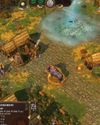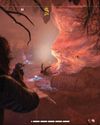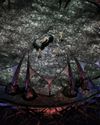
This is the way the world ends”, wrote TS Eliot in his 1925 poem The Hollow Men. “Not with a bang but a whimper.” It’s hard to say if Eliot was writing directly about Nvidia and AMD’s support for multi-GPU setups or speaking more allegorically. Perhaps we’ll never know. What we can all roundly agree on is that Eliot lands on a truism when it comes to technology in general: there’s never an announcement. Yesterday’s Next Big Thing is instead quietly escorted out of the building and stuffed into a bin away from prying eyes.
We didn’t get any press releases confirming the formal demise of 3D TVs in the mid-2010s, we’ll get no such PR when VR dies in 2030 (fight me), and neither SLI nor Crossfire got the official state funerals they deserved when, at some point in the last five years, multi-GPU PC builds simply stopped being a thing.
The concept is an old one. Even in the days before 3DFX was the last word in PC gaming graphics hardware, before the Nvidia buyout, the company behind Voodoo was finding ways to run two of its cards in parallel. Voodoo 2 introduced scan-line interleave (SLI) support in February 1998. For context, that’s three months before Unreal came out, and only a few weeks after the discovery of penicillin.
To the consumer, it worked just like later iterations of SLI and Crossfire did: you placed two identical graphics cards in your motherboard’s PCI slots, and connected them with a proprietary ribbon cable. That enabled your two Voodoo 2s to process graphical rendering tasks in parallel for faster performance. That was the theory.
EARLY PROBLEMS
This story is from the {{IssueName}} edition of {{MagazineName}}.
Start your 7-day Magzter GOLD free trial to access thousands of curated premium stories, and 9,000+ magazines and newspapers.
Already a subscriber ? Sign In
This story is from the {{IssueName}} edition of {{MagazineName}}.
Start your 7-day Magzter GOLD free trial to access thousands of curated premium stories, and 9,000+ magazines and newspapers.
Already a subscriber? Sign In

A New Dawn - The rise, fall and rise again of PC Gaming in Japan
The so-called 'Paso Kon' market (ie katakana's transliteration of 'Pasonaru Computa') in Japan was originally spearheaded in the 1980s by NEC's PC-8800 and, later, its PC-9800.

MARVEL: ULTIMATE ALLIANCE
Enter the multiverse of modness.

SLIDES RULE
Redeeming a hated puzzle mechanic with SLIDER

GODS AND MONSTERS
AGE OF MYTHOLOGY: RETOLD modernises a classic RTS with care

PHANTOM BLADE ZERO
Less Sekiro, more Wo Long: Fallen Dynasty

STARR-MAKING ROLE
Final Fantasy XVI's BEN STARR talks becoming a meme and dating summons

THIEF GOLD
Learning to forgive myself for knocking out every single guard.

HANDHELD GAMING PCs
In lieu of more powerful processors, handhelds are getting weirder

FAR FAR AWAY
STAR WARS OUTLAWS succeeds at the little things, but not much else shines

FINDING IMMORTALITY
Twenty-five years on, PLANESCAPE: TORMENT is still one of the most talked-about RPGs of all time. This is the story of how it was created as a ‘stay-busy’ project by a small team at Black Isle Studios